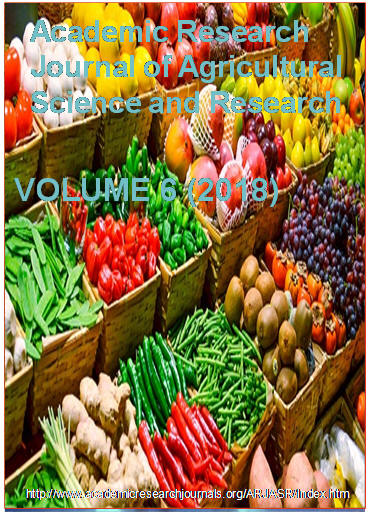| ARJASR |
Academic Research Journal of
Agricultural Science and Research |
||||||||||||||||||||||
|
Academic Research Journal of Agricultural Science and Research Vol. 6(7), pp. 370-379. September, 2018. ISSN: 2360-7874 DOI: 10.14662/ARJASRD2018.049 Full Length Research Longitudinal Analysis of Arabica Coffee Bean Yield: Application of Linear Mixed Model for Clustered Longitudinal Data Tarekegn Argaw1, Girma Taye2, Dechasa Bedada3, Ashenafi Ayano4
1Biometrics, Ethiopian Institute of Agricultural Research, P. O. Box 2003, Addis Ababa, Ethiopia 2Associate Professor, School of Public Health, Addis Ababa University, P. O. Box 9086, Addis Ababa, Ethiopia 3Department of Statistics, College of Natural Science, Jimma University, P.O. Box 378, Jimma, Ethiopia 4 Ethiopian Institute of Agricultural Research ,Jimma Agricultural Research Center, P.O. Box, 192, Jimma, Ethiopia Corresponding authorís E-mail: tare.aragaw@gmail.com
Accepted 26 September 2018
The study
aimed to do longitudinal analysis to investigate the effect of time,
biennial, and correlation on Arabica coffee bean yield by using
Exploratory Data Analysis (EDA) and Linear Mixed Model (LMM). The data
for this study came from coffee variety field trials conducted by Jimma
Agricultural Research Center (JARC) over 7 years during 2005-2011 in
south west Ethiopia across 3 coffee growing areas (Jimma, Agaro, and
Metu). The experimental design of the trial was RCBD with 4 replications
and 17 Arabica coffee genotypes. The LMM results revealed that the
heterogeneous variance function (varIdent) and autoregressive order
three (AR3) were, respectively, found to give better fit to the variance
and correlation structure among measurements of coffee bean yield.
Biennial interacts significantly with location and genotype. The
estimated variance of random effect of block associated with intercept
and biennial were σ ̂^2 (b0j) = (221.81)2 and σ ̂^2 (b3j) = 145.242,
respectively. The result also showed significant location by linear and
quadratic time effect interactions. Estimates of quadratic time effects
for Jimma, Agaro, and Mutu were, respectively, -151.51, -66.05, and -4,
whereas estimates of linear time effects for these locations were
158.92, 158.92, and 31.08, respectively. It was observed that the
measurements of coffee bean yield obtained from Arabica coffee tree over
time induced an autocorrelation which is known as serial correlation.
There was initially an increasing andgradually a decreasing trend in
Arabica coffee bean yield over time/years with linear rate of growth.
There was also a differential response of genotypes and environments in
the presence and absence of biennially. The effects of correlation among
measurements, time, and biennial have to be considered in Arabica coffee
breeding research to improve the precision and accuracy of research
outcomes by using advanced statistical models. How to cite this article (APA Style): Argaw, T., Taye, G., Bedada, D., Ayano, A. (2018). Longitudinal Analysis of Arabica Coffee Bean Yield: Application of Linear Mixed Model for Clustered Longitudinal Data. Acad. Res. J. Agri. Sci. Res. 6(7): 370-379 |
|
|||||||||||||||||||||
